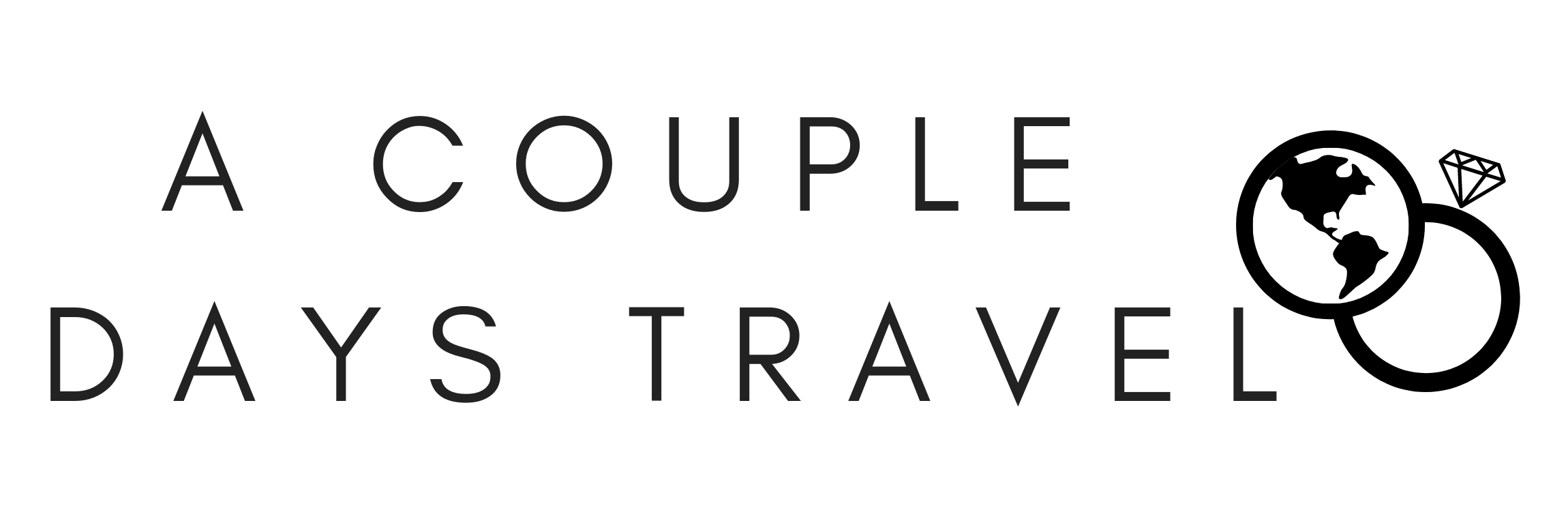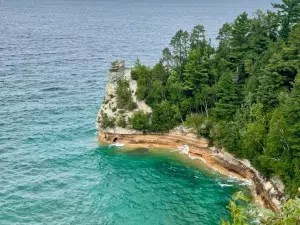If you’ve ever wondered how many grains of sand are on a beach, you’re mind will be blown thinking of how many grains of sand make up Sleeping Bear Dunes! Sleeping Bear Dunes National Lakeshore is home to the famous Sleeping Bear Dunes, two islands, miles of Lake Michigan lakefront, 5+ inland lakes, several campgrounds, and miles of hiking and biking trails. So how do you spend your time at Sleeping Bear Dunes? Keep reading to find out.
Stuff In This Post
ToggleWhen to Visit Sleeping Bear Dunes National Lakeshore
Summer is the best time to explore Sleeping Bear Dunes National Lakeshore. While the park is open year round. All of the trails within the park are open between Memorial Day and Labor Day. Also, anyone who’s ever visited Michigan lakeshores knows that the “lake breeze” is a thing. So the cool breeze coming off of Lake Michigan creates a cool wind, which means the warm weather in the summer is the best time to visit. However, it is also the most popular time to visit. You’ll find the main dunes pretty crowded and some of the smaller roads congested, especially on weekends in the summer.
Fall is also a very nice time to visit Sleeping Bear Dunes. There are lots of beautiful trees here which all turn pretty colors in the autumn. Again though, if you visit during the color change, it will be crowded as it is one of the most popular drives in Michigan for the color change.

How to Get To Sleeping Bear Dunes
Sleeping Bear Dunes is on the northwest coast of Michigan’s Lower Peninsula.
Traverse City is the closest city with an airport. However, as this is a small airport, prices can be expensive. Grand Rapids also has an airport and flights into this airport tend to be cheaper.
Where ever you come from, you want to make your way to M-22, a beautiful highway along the coast.
You will need your own vehicle to explore Sleeping Bear Dunes. Part of the fun of the park is the scenic drives throughout. Also, the park is too far from major towns to make ride shares or taxis and economical option.

How Long To Stay At Sleeping Bear Dunes
We think that one day is the perfect amount of time to spend at Sleeping Bear Dunes National Lakeshore. You’ll be able to do all of the trails listed below or choose a few and then spend some time on the beach. If you are a more avid hiker or are interested in biking the many trails in the park, you should plan to spend a weekend in the park.
What to Budget for a Sleeping Bear Dunes Visit
The cost is $25/vehicle for entrance into the park. This pass is good for 7 days from the date of purchase. You can also use or purchase and $80 America the beautiful National Parks pass if you are planning on visiting other National Parks in the course of that year. You can purchase either pass at the Visitors Center in the nearby town of Empire or purchase a Sleeping Bear pass throughout the park at the payment kiosks. However, you must pay with a card as cash is not accepted in the park.
There are several small restaurants in Glen Arbor or Empire. Meals in these areas are a bit higher than surrounding towns, considering the touristy area. Plan for $25/person for a sit down lunch and a bit more for dinner. However, we think the better option of lunch is a picnic you pack and take to a dune!
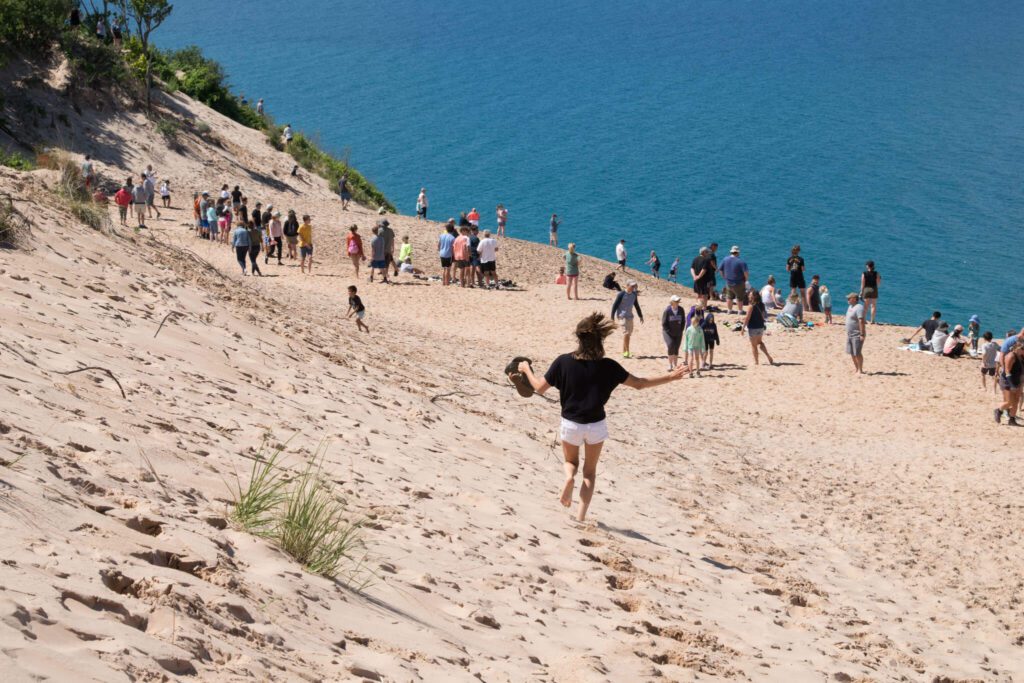
Things to Do At Sleeping Bear Dunes National Lakeshore
Hiking At Sleeping Bear Dunes
Hiking is one of the most popular things to do at Sleeping Bear Dunes National Lakeshore. There are 13 hiking trails throughout the park. The park encourages folks to hike all of them in one year, though you’ll definitely need more than one day to do that. We’ve included some of the most popular trails below.

Empire Bluff Trail
Distance: 1.5 miles out and back | Elevation Gain: moderate | Time: 45 minutes | Difficulty: moderate
This popular trail will take you through the woods to give you glimpses of miles of shoreline. This is one of the shortest and easiest trails with a view in the park.

Cottonwood Trail
Distance: 1.6 miles | Elevation Gain: minimal | Time: 30 minutes | Difficulty: easy
This is the most informational trail in the park. You can take this easy loop trail and read the informational signs staged throughout the trail. These signs will help you to understand the ecology of the dunes and the lakeshore.
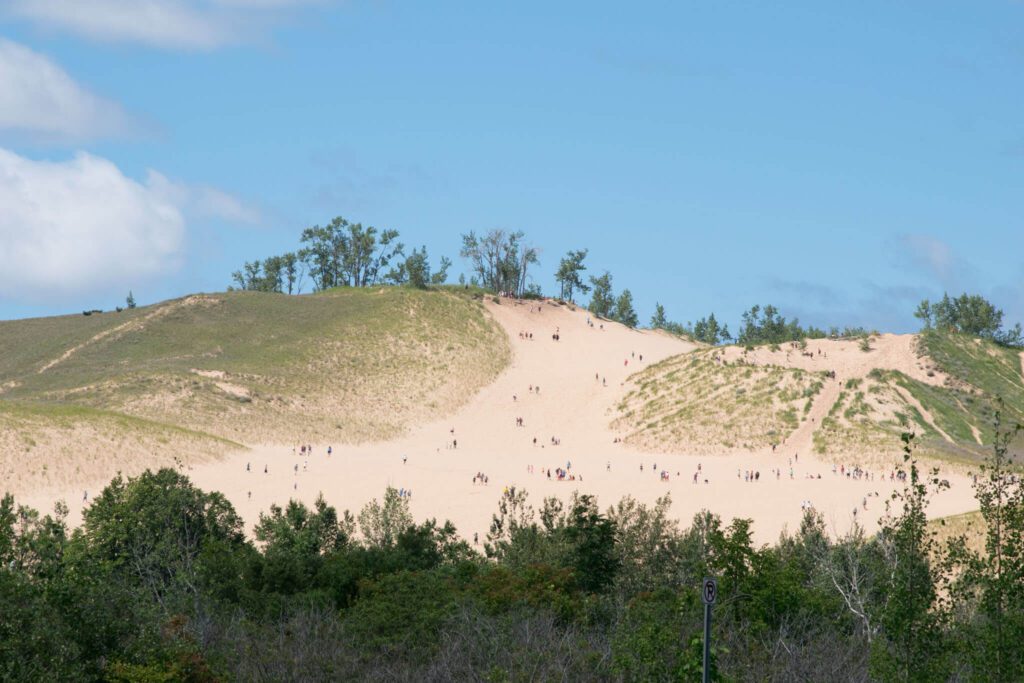
Dune Climb
Distance: 3.6 miles out and back | Elevation Gain: extreme | Time: 1.5-2 hours | Difficulty: hard
The Dune Trail is hard but fun. You’ll hike through sandy hills until you get to a dune on the shores of lake Michigan. Don’t let the difficulty fool you, tons of people tackle this hike, including families with children with far more energy than us. Lots of families wear swimsuits and pack lunch. After the exerting hike, you’ll want to rest by the lakeshore before you make the return journey.
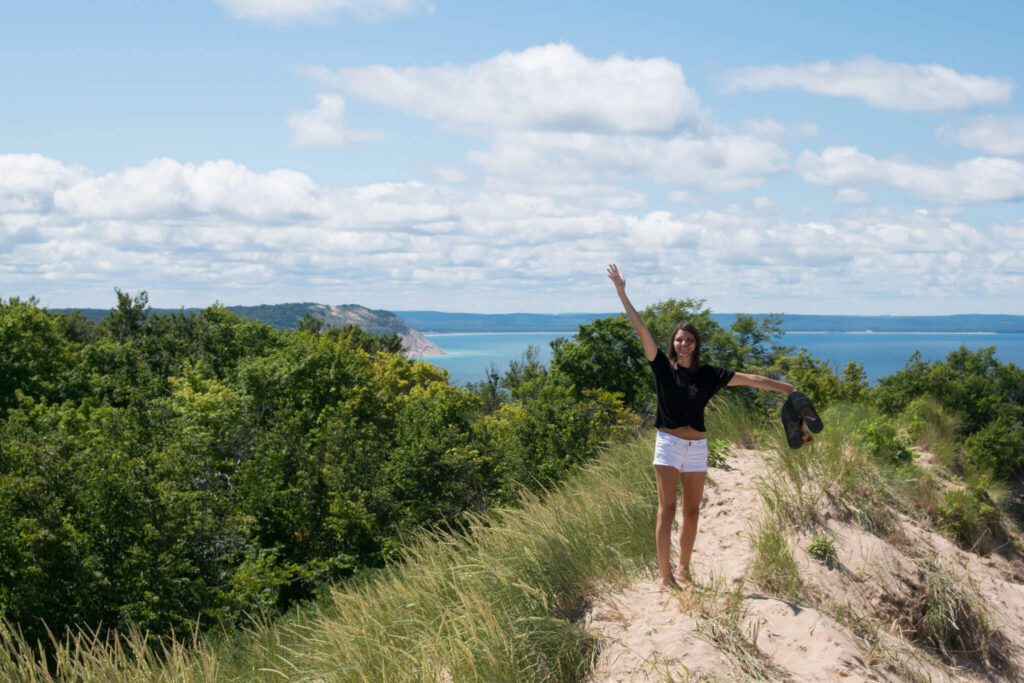
Sleeping Bear Point
Distance: 2.5 miles | Elevation Gain: moderate | Time: 1 hour | Difficulty: moderate
This loop in the northern section of park gives more great views as you walk through various ecosystems of the park including dunes and woods. While nothing on this trail is extraordinary, the best part of this trail is it does give you a large overlook of the things offered in the park.

Pierce Stocking Scenic Drive
If you only do one thing at Sleeping Bear Dunes National Lakeshore, this should be it. Most people drive this loop and some bike it. It’s a 8 mile loop to some of the best viewpoints and short trails in the park. There are 12 stops and all of them bring even more interesting views with the Lake Michigan Overlook being the best. While you may see plenty of dunes here, these ones are not for climbing. These dunes are dangerously steep.
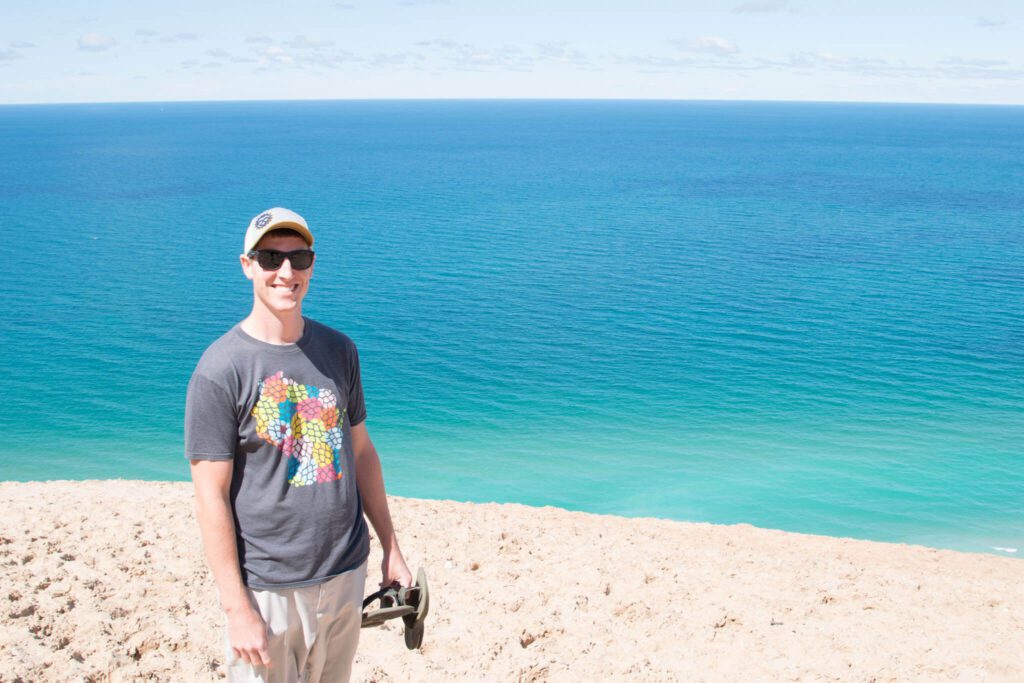
Lake Michigan
Take a dive into the cool waters of Lake Michigan. As Michigan natives, we love the great lakes: no salt and no sharks but basically seas! The beaches in Sleeping Bear Dunes park are great as they are sandy and clean.
Manitou Islands
Visit South or North Manitou Island for some quiet camping and hiking. These islands are covered in hiking trails and are a great place for backcountry camping. However, you will need to book your ferry ahead of time if you are visiting in the summer as tickets can sell out early in the day. If you plan on camping on the islands, make sure to secure a backcountry permit or a campground reservation ahead of time.

Safety On the Dunes
The dunes will tell you if they are climbable. The park does a really great job of listing how long a dune climb typically takes. The park also lists the typical cost for rescue if you are unable to climb back up the dune. Do not over estimate your fitness level. If you want to climb a dune, take the dune climb trail. Don’t go rogue on another dune.
Additionally, there are several dunes that you should not climb at all due to the fragile ecosystem of the dune. Climbing these dunes can damage years of plant growth and leads to erosion and the disappearance of dunes and beaches. Don’t be a son of a beach, stick to the marked trails.
Where To Stay Near Sleeping Bear Dunes
Sleeping Bear Dunes National Lakeshore has two campgrounds inside the park. These are the most economical offerings for accommodations.
As this is a popular tourist destination there are plenty of home rentals nearby. If you are interested in staying in a hotel, Traverse City is nearby and has plenty of resorts and hotels. We stayed in Traverse City and enjoyed our stay.
What to Pack For Visiting Sleeping Bear Dunes
You’ll be on the beach or near the beach all day. So make sure to pack plenty of sun protection. Whether you want hats, sun shirts or sunscreen, you’ll need it with all of the sun shining down on up and up at you from the water.
While hiking is a popular activity, hiking shoes here would not be my first option. All of the dune hiking, we did barefoot. So having sandals that we could easily slip on and off were best for us. I really like my “hiking sandals” and Scott did all of his hiking in flip flops.
We hope you’re ready to start planning your own Sleeping Bear Dunes vacation. It’s one of our favorite places in Michigan and is a really impressive sight. If you have any suggestions for a visit or questions while planning your own trip, please leave them in the comments section below.
